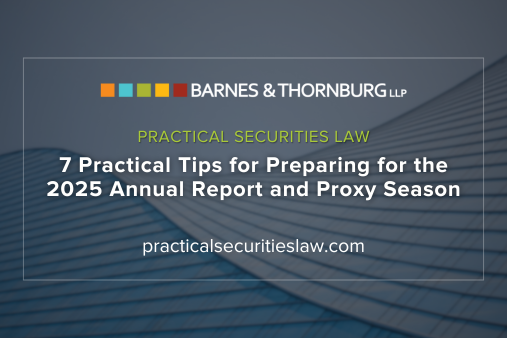The FDA recently issued a draft guidance titled “De Novo Classification Process (Evaluation of Automatic Class III Designation).” This draft guidance implements changes to the de novo process that were required as a result of the FDA Safety and Innovation Act (FDASIA) from July 2012.
As noted in the draft guidance, new devices that FDA has not previously classified are “automatically” or “statutorily” classified into class III, regardless of the level of risk they pose or the ability of general and special controls to assure their safety and effectiveness. By definition, a new type of device would not have been on the market before the 1976 medical device amendments to the Food, Drug & Cosmetics Act or that has since been classified into Class I or Class II. Thus, there would be no available predicate device for a 510(k) application.
In 1997, Congress created the de novo process so that low to moderate risk devices automatically placed into Class III could be approved without having to go through the expensive and time-consuming pre-market approval (PMA) process. Before FDASIA, however, such a device would still have to go through the 510(k) process and receive a “not substantially equivalent” (NSE) finding before it could go through the de novo process. As a result, the de novo process was not used often. FDASIA sought to change that by allowing a firm to pursue the de novo process without first filing a 510(k).
According to the draft guidance, FDA will consider de novo petitions for new types of devices, including devices which do not fall within any classification regulation where the de novo requester either determines that there is no predicate device or has received a NSE determination on a 510(k) submission. For devices that have already undergone 510(k) review, FDA states that it will consider a de novo petition if the device has been determined to be NSE due to: (1) the lack of an identifiable predicate device, (2) a new intended use, or (3) different technological characteristics that raise different questions of safety and effectiveness.
The draft guidance goes on to identify two mechanisms by which firms can pursue a de novo petition. First, a firm can request a Pre-Submission (Pre-Sub) meeting, described as a useful way to obtain early feedback on whether a device may be suitable for the de novo process and/or to advise the firm on the documentation needed in a subsequent de novo petition. The draft guidance states FDA believes a Pre-Sub is most useful after the firm has identified the proposed intended use and key aspects of the device design sufficient to permit a meaningful discussion. Second, a firm may simply file a de novo petition, with or without first having filed a 510(k). The draft guidance cautions firms considering this direct route that their success will depend on how well they search for a potential predicate device, identify the risks and special controls (if applicable), and define and collect adequate data to provide reasonable assurance of safety and effectiveness.
The draft guidance also summarizes the contents of a Pre-Sub as follows:
- The firm’s proposed classification (Class I or II) and proposed applicability of 510(k) requirement (exempt or not). The firm should state why it believes general or general and special controls are adequate to provide reasonable assurance of safety and effectiveness.
- The searches of FDA public databases and other resources, including terms, used to establish that no legally marketed device of the same type exists. The firm should provide a list of regulations, PMAs, and/or product codes that may relate to or are potentially similar to the subject device.
- Where necessary for FDA to consider these specific questions, the Pre-Sub should also include the following:
- Identification of each risk associated with the device and the reason for each risk (tracing back to risk analysis, clinical testing, etc.).
- Information regarding the safety and effectiveness of the device. Firms should cite the available data/studies relating to the device’s safety and effectiveness.
- Protocols for performance and clinical testing, including how they will address the risks you anticipate and targeted performance levels which will demonstrate that general controls or general and special controls are sufficient to provide reasonable assurance of safety and effectiveness.
- The proposed mitigation(s)/control(s) for each risk based on the best available information at the time of the submission.
Attachment two to the draft guidance is a two and one-half page summary of the proposed contents of a de novo petition. The proposed sections include (1) administrative information, (2) regulatory history, (3) device information and summary, (4) change summary (if appropriate), (5) classification summary, (6) classification recommendation, (7) proposed special controls (Class II only), (8) supporting protocols and/or data, (9) summary of benefits, (10) summary of known and potential risks, (11) risk and mitigation information, (12) benefit-risk considerations, and (13) device labeling.
A pdf copy of the draft guidance is available here.
For more information, please contact the Barnes & Thornburg LLP attorney with whom you work or one of the following attorneys in the firm’s Food, Drug & Device Group: Lynn Tyler at (317) 231-7392 or lynn.tyler@btlaw.com; Hae Park-Suk at (202) 408-6919 or hae.park.suk@btlaw.com.
Visit us online at www.btlaw.com/food-drug-and-device-law-practices.
©2014 Barnes & Thornburg LLP. All Rights Reserved. This page, and all information on it, is proprietary and the property of Barnes & Thornburg LLP. It may not be reproduced, in any form, without the express written consent of Barnes & Thornburg LLP.
This Barnes & Thornburg LLP publication should not be construed as legal advice or legal opinion on any specific facts or circumstances. The contents are intended for general informational purposes only, and you are urged to consult your own lawyer on any specific legal questions you may have concerning your situation. Visit us online at www.btlaw.com and follow us on Twitter @BTLawNews.











/Passle/6488d4630e7e25c9ac9f834a/SearchServiceImages/2025-01-10-22-16-01-995-67819c21f01b92931abcaac4.jpg)

